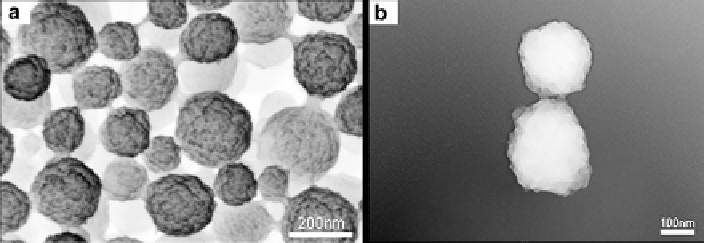Biomedical Engineering Reference
In-Depth Information
This novel formulation is expected to possess extended residence time in the
gastrointestinal tract; however, no in vivo pharmacokinetic investigation was con-
ducted to show the feasibility and efficiency.
Another interesting strategy could be the use of polymer nanoparticles based on
the copolymer of methylvinylether and maleic anhydride (Gantrez AN from Isp.
Corp.). This copolymer permits the preparation of nanoparticles under “soft” condi-
tions and the resulting carriers have demonstrated a high ability to develop bioadhe-
sive interactions within the gastrointestinal tract (Arbos et al.
2002
). More important,
the surface of these poly(anhydride) nanoparticles can be easily modified by simple
incubation with different excipients or ligands in order to modify their fate within the
gastrointestinal tract (Arbos et al.
2003
; Salman et al.
2005
; Yoncheva et al.
2005
). In
this context, some compounds such as albumin (Arbos et al.
2003
) or chitosan [data
not published] permit to modify the distribution of these nanoparticles within the gut,
whereas some excipients such as cyclodextrins or polyethylenglycols can be of inter-
est to inhibit the activity of P-gp and the activity of CYP3A4 (Agueros et al.
2009
).
In this context, using 5-fluorouridine (FURD) as model, the potential of serum
albumin-coated poly(methylvinylether -co- maleic anhydride) nanoparticles (SA-NP)
were evaluated. These nanoparticles were capable to specifically target the stomach
mucosa and develop strong bioadhesive interactions in this part of the gut after their
oral administration in laboratory animals (Arbos et al.
2003
). From urine data, the
FURD bioavailability when loaded in either SA-NP or in uncoated nanoparticles
was about 79% and 21%, respectively. For the control oral solution this parameter
was calculated to be only 11%. These values correlated well with the presence of
FURD metabolite in the lumen of animals (Arbos et al.
2004
).
More recently, and in a different approach, the combination between
poly(anhydride) nanoparticles and cyclodextrins have been demonstrated effective
to significantly improve the oral bioavailability of paclitaxel (see Fig.
2
) (Agueros
et al.
2010
). Cyclodextrins have been used for a double purpose: as a solubilising
agent of paclitaxel, which it is an extremely lipophilic compound, and for the capa-
bility of these oligosaccharides to disturb and inhibit the activity of the intestinal
P-glycoprotein (Ishikawa et al.
2005
; Arima et al.
2001
).
Fig. 2
Microphotographs of paclixatel loaded cyclodextrin-poly(anhydride) nanoparticles obtained
by scanning electron microscopy (
a
) and transmission electron microscopy (
b
)

Search WWH ::

Custom Search